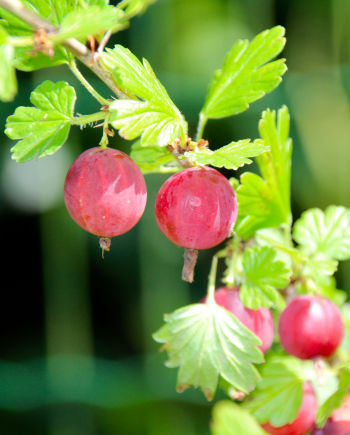What Are The Benefits Of Eating Gooseberries Daily? Amla?

Gooseberries have been consumed for centuries just as they are, straight of the bush.
They're also very tasty to make jam out of or have as the main ingredient in a delicious pie. Adding gooseberries to your diet can be a challenge because they can be difficult to find in many supermarkets.
But it's well worth securing a way to incorporate them into your diet as they can provide many health benefits to you!
For instance, they contain a lot of antioxidants which help protect you against cellular damage and oxidative stress.
Healthy adult men and women need at least 2 cups of fruit every day. Only 1 cup of fresh berries such as gooseberries counts as a serving of fruit according to USDA.
Each cup of gooseberries contain only 66 calories and is considered an excellent source of vitamin C and A, carotenoids, fiber, potassium and flavonoids.
Gooseberries are considered to be good for your skin, as they might help cure many skin conditions.
Furthermore, the berries can make you more alert and can also improve your memory.
Table of Contents
Gooseberries Are Packed With Nutrients
The berries are rich in potassium, magnesium, vitamin A and calcium. Gooseberries can be effective against diarrhea. This super berry has been used for hundreds of years to overcome liver diseases, anemia, urinary tract problems, and heart, vascular and respiratory problems.
Gooseberries are a good source of Vitamin C. One cup serving of raw gooseberries contains over 41,5 milligrams of vitamin C, which represents 55% of a woman’s recommended daily intake and 46% for a male’s recommended daily intake.
Gooseberries are also a great source of Vitamin A. One cup serving of raw gooseberries contains around 18% of your recommended daily intake of vitamin A. The vitamin A contained in gooseberries is in the form of carotenoids.
Gooseberries are also an excellent source of essential dietary fibers. One serving of the fruit contains around 26% of the recommended daily intake of fiber. Consuming a healthy amount of insoluble fiber in your diet helps take care of many digestive problems and improves overall digestive health.
Facts About The Small Gooseberry
Gooseberries can be described as small Ribes fruits with red or green firm skin, that contain a lot of nutrients. Even though the Gooseberry is bigger than it’s relative, the currant, the gooseberries are still considered small.
Gooseberries are small, firm, almost translucent fruits which grow wild on thorny bushes in various parts of the world.
The gooseberries originate from Europe. They were cultivated in Africa and Asia before the British started to cultivate newer varieties in around the 16th century.
Although there are many cultivars, there are actually just two main types of gooseberry. The European gooseberry and the American gooseberry. The European gooseberry scientifically known as Ribes uva-crispa is larger and according to many tastier than its American counterpart. It’s described to have more and a sweeter flavor.

Gooseberries are a hardy fruit that can thrive in extreme conditions from hot humid summers to freezing cold winters. There are some differences between varieties. For example, most gooseberry bushes have thorns, but there are thornless varieties of gooseberry bushes that you can find, but they are not as hardy as the thorny varieties. They need a warmer climate.
In North America, you can pick fresh gooseberries in July and August. They typically ripen around late summer, early autumn. One way to test if the berries are ripe is to squeeze them gently between your fingers, they're soft when ripe.
If you want to know more about the regular, true Gooseberry, we've got an article that will do the trick!
Are There Any Benefits Of Dried Gooseberry?
There are several benefits of dried gooseberries. The best properties with dried fruit is that it contains exactly the same nutrients as the fresh berry while having a very long shelf life.
Dried gooseberries are perfect to bake with. You can have them in a pies or crumble, just like you would have used fresh ones. You can actually use dried gooseberries in most dishes you usually use fresh gooseberries in.
Dried gooseberries are also delicious to have in a salad. They won't just look beautiful, they'll also taste amazing. It adds that extra dimension to a meal.
If you have dried gooseberries at home and want to make a jam. it’s actually possible. What you need to do is to re-hydrate the dried berries. All you need to do is put them in a bowl of water overnight. I recommend you to boil the berries in the same water that you left them in during the night. This will give you a jam that retains all the rich flavors of the fruit.
Dry Gooseberries yourself?
You can actually dry gooseberry yourself, if you have access to fresh ones. It's very easy but takes quite a long time. You do it in your own oven.
All you have to do is: split the berries in the middle and place them on a baking paper. Put the berries in the oven with an oven temperature on approx. 40–50 °C for about 7 hours. Then you need to let them cool for a while.
Where to buy dried Gooseberries
Take a look at our Recommended By Care Omnia: Gooseberries page where we recommend what dried Gooseberries to choose, why we recommend them and also where to buy them.
How To Eat A Gooseberry

Gooseberries can be eaten as they are, or used as an ingredient in desserts, pies or crumbles. Early pickings are generally sour and more appropriate for culinary use. The sour berries contain more pectin, which make them better suited to make jam of.
Before you eat the berries you have to top and tail the berries first, a tedious task. If you have picked lots of berries you might want to get some help!
When picked fully ripe, gooseberries can be quite sweet, and when they are picked prematurely they are usually sour and tart in flavor, however, they are often picked early for commercial purposes. This because the unripe fruit has a longer shelf life and sour fruit are commonly used in cooking.
The gooseberries are also used to flavor beverages such as sodas, flavored waters and are also used in fruit wines and teas.
Gooseberries can be preserved in the form of jams, dried fruit, or as the primary or a secondary ingredient in pickling, or stored in sugar syrup.
These delicious gooseberries are perfect for making preserves and fruit desserts but can also be used for making cooking sauces for poultry or pork dishes.
A jam or chutney of gooseberries is delicious and you can make it yourself. I recommend you vary the flavor some by adding other fruits in the jam aswell. This will change both the texture and the flavor of the jam. Experiment until you get it just right. Perhaps your work will result in a secret family jam recipe!
When picking gooseberries you should try to pick fresh gooseberries with healthy skin. This to ensure that the fruit retains as many nutrients and health benefits as possible.
Gooseberries can be stored in the refrigerator for several days or more and if you still haven't eaten all of them after a few days, the gooseberries freeze very well. If you get your hands on a lot of gooseberries at ones, you should consider freezing a good amount of them to keep them from spoiling.
Gooseberries Are Also Beneficial For Your Beauty!

Did you know that you might look younger just by eating gooseberries? Or that eating gooseberries might help you hide your first gray hair?
Gooseberries have a high antioxidant value ◳ which means they are excellent for our internal health. But not only do free radicals damage our insides, they also have a significant effect on our appearance making many people look much older than they really are.
Eating gooseberries and other antioxidant rich food can slow down this inevitable process and may even help reverse some of the signs by clearing up wrinkles and other age marks on the skin.
There are also people claiming that gooseberries actually have beneficial effects on your hair. More precisely early graying of hair. You can try it out by boiling some water with gooseberries and wait for it to cool down. The water is then used to wash your hair with. You should repeat this frequently to get the best result.
Another Names For Gooseberry
Gooseberries aren't known by many different names. They have their scientific name. There are also different kinds of fruits that are named gooseberry, but these are not botanically related to Gooseberries.
There are two main species of gooseberry that are grown – the European with the scientific name Ribes uva-crispa (sometimes called Ribes grossularia), and the American, that has the scientific name Ribes hirtellum, both of which are from the family Grossulariaceae, a family of flowering and edible currants.
Another name that is usually used in Britain, is goosegog.

Different Types Of Gooseberries
A gooseberry often has a green color with light colored stripes, but it can be red, yellow, purple, or white, depending on the species and variety, and it usually contains many small edible seeds in the flesh of the fruit. The berries can have thorny, hairy or even skin. The different varieties are distinguished from each other by the time of maturation, taste, color, size, shape of the fruit and the way in which it is consumed.
There are a few fruits that are called gooseberry, but despite their names, they are not botanically related to gooseberries.
Chinese Gooseberry
Chinese gooseberries are native to north-central and eastern China more commonly known as Kiwifruit. It’s a hairy brown skin and dark green flesh with fine black seeds. It doesn't look at all like a gooseberry. Despite its name, it is not botanically related to gooseberries.
In 1904 the Chinese Gooseberry was described as “edible fruits in the size of walnuts, and the flavor of ripe gooseberries", that description lead to the name Chinese gooseberry.
Cape Gooseberry
There is a berry that is sometimes mistaken for a gooseberry. It’s the Cape gooseberry, also known as Physalis peruviana, Despite its name, this berry is not botanically related to gooseberries. The berries are small, round, orange-yellow in color, encased inside a Chinese lantern like a papery thin husk.
Indian gooseberry (Amla)
The Indian gooseberry, also called Amla is a sour fruit which can be found in the wet hilly areas and in the autumn season. It is known for its amazing nutritional content and is used for a number of purposes.
Indian gooseberry is a fruit with a round to transversely spherical shape with light green color. Amla berries contain exceptionally high levels of anti-oxidants and vitamin C. This makes them excessively acidic and bitter in taste.
Indian gooseberry is a tree that grows in India, the Middle East, and some southeast Asian countries. Indian gooseberry has been used in medicine for thousands of years. Today people still use the fruit of the tree to make medicine.
The tree of this fruit is considered sacred in India. These fruits are small and light green in color with six vertical grooves on them and a hard seed inside. It's quite nourishing but has an extremely sour astringent taste.
Medicinal value of Amla
Amla is the most important medicinal plant in the Indian traditional system of medicine. Various parts of the plant are used to treat a range of diseases, but the most important part is the fruit.
The fruit is used either alone or in combination with other plants to treat many ailments. It's uses include
- Medicine for the common cold and fever
- As a Diuretic
- As a Laxative
- As a Liver tonic
- As Refrigerant
- As Stomachic
- As Antipyretic
- As Anti-inflammatory
- As Hair tonic
- To prevent peptic ulcer and dyspepsia
- As digestive enchancing
There have been lots of studies made on the effectiveness of Amla.
In screening tests, the Amla berry emerges as an incredibly potent antioxidant. In one study, extracts of a thousand different herbs ◳ were screened for the level of super oxide radical scavenging activity and heat resistance. The results of the study show that the Amla berry was among the top four of the tested foods with the highest levels of both of the properties screened for. So the Amla is not only a potent antioxidant, it's also very heat resistant.
The European Journal of Cancer Prevention, published in May 2011: "A wonder berry in the treatment and prevention of cancer". ◳ They reported that the Amla have properties that are effective in the treatment and prevention of cancer. Pre-clinical studies carried out in the past two decades have clearly shown that Amla possesses antineoplastic, chemomodulatory, chemopreventive, and radioprotective effects. Although studies on the effects of Amla on some cancer cell lines substantiate its effectiveness, countless possibilities for further research still remain. Amla might have the potential to someday become an effective nontoxic anticancer treatment.
Another study of Amla was made to determine the efficacy of Amla on dermal wound healing in vivo. This study provides firm evidence to support that topical application of Amla represents a feasible and productive approach to support dermal wound healing. ◳
If you are interested in the dried gooseberries. The dried Amla might be a good alternative. Dried amla is the highest concentrated natural source of antioxidants ◳, according to an analysis made in 2010.
Where to buy Amla (Indian Gooseberries)
Take a look at our Recommended By Care Omnia: Gooseberries page where we list our top recommendations of quality products made of Amla. There's powder, dried or juice to choose from!
Conclusion: Add Gooseberries To Your Diet Today

Gooseberries are great! There are several benefits of eating gooseberries on a daily basis.
The gooseberry is very nutritious. It contains vitamins, minerals and antioxidants that are good for you.
The vitamin C content in the gooseberries is considered high. But as the chart above shows it doesn't even come close to the Indian gooseberrys vitamin C content. Amla, has about 17 times more Vitamin C than Gooseberries!
This superberry has been used for hundreds of years to overcome liver diseases, anemia, urinary tract problems, and heart, vascular and respiratory problems.
There is so much you can do with the berries if you don’t want to eat them as they are. You can have them in all kinds of meals or desserts. You can make a jam of them or even dry them yourself.
Gooseberries are delicious, kids love them and they are packed with nutrients. Add them to your daily diet if you are able!
Are gooseberries good for you?
Yes, gooseberries are packed with nutrients. Gooseberries are a good source of vitamin C, vitamin A and essential dietary fibers. It has been used for hundreds of years to overcome liver diseases, anemia, urinary tract problems but also heart, vascular and respiratory problems.
Can I eat gooseberries daily?
Yes, gooseberries are a good addition to your daily diet. Studies show that you get several benefits of eating gooseberries daily to improve your overall health.
How to eat gooseberries?
There is so much you can do with the berries if you don’t want to eat them as they are. You can have them in all kinds of meals or desserts. You can make a jam of them or even dry them yourself. You get the most benefits from eating gooseberries fresh/raw as heating destroys some of the nutrients it can provide.
What are the differences between gooseberries and amla?
Gooseberry and Amla, the Indian gooseberry aren't really alike, except by their name. Amla’s vitamin C content is absolutely of the charts. Amla has about 17 times more vitamin C than gooseberries.


